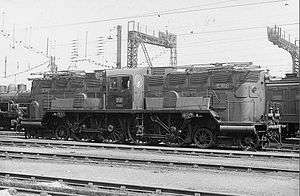2BB2 400
 |
| Type and origin |
|---|
| Power type |
Electric |
|---|
| Builder |
Ganz Works, Hungary |
|---|
| Serial number |
E.401 E.402 |
|---|
| Build date |
1926 |
|---|
| Total produced |
2 |
|---|
|
|
|
| Performance figures |
|---|
| Maximum speed |
120 kilometres per hour (75 mph) |
|---|
| Power output |
4,800 horsepower (3,600 kW) |
|---|
| Tractive effort |
176 kilonewtons (40,000 lbf) |
|---|
|
| Career |
|---|
| Operators |
PO SNCF |
|---|
| Number in class |
2 |
|---|
| Nicknames |
Les Belles Hongroisses |
|---|
| Axle load class |
18,000 kilograms (40,000 lb) |
|---|
|
The 2BB2 400 class were two electric locomotives built in 1926 for the Paris Orléans (PO) railway of France.[1]
After wartime coal shortages during World War I, post-war reconstruction from 1919 focussed on electrification, powered by hydro electricity. In 1923 the PO began electrification of the 200 km section of the Toulouse main line from Paris to Vierzon using a supply of 1,500V DC. The Ganz Works of Budapest, Hungary supplied these two locomotives, to the design of Kálmán Kandó.[1]
The arrangement of the locomotives was unusual for DC locomotives and may have been influenced by Kandó's other designs for AC locomotives, with the large diameter frame-mounted AC motors of the period. The four motors were mounted rigidly on the frames, above the driving wheels. Each motor drove an external jackshaft crank, with the four driving axles coupled in pairs. Drive between the motor jackshafts and the wheels was by coupling rods. As express passenger locomotives, this also permitted large diameter driving wheels, rather than small-wheeled bogies beneath the frames. Suspension travel between the driven wheels and the fixed motors was achieved through Kandó's triangular linkage design.[1][2][3]
The coupled wheels, rather than individual traction motors, encouraged resistance to wheelslip. This advantage was recognised and influenced future French designs, such as the typically French monomotor bogie rather than the axle-hung traction motors used elsewhere.[1]
In service, the locomotives proved fast and powerful, but were unreliable. When other passenger locomotives became available, they were restricted to freight work at up to 80 kilometres per hour (50 mph). Despite this they were popular with their crews, encouraged by the French practice of attaching crews to the same locomotive. They gained the class nickname, Les Belles Hongroisses.[1] Their later years were spent in freight-only service based at Limoges. They survived into SNCF service in 1938, keeping their original numbers, but were withdrawn and scrapped that year.[lower-roman 1]
Notes
- ↑ Some sources give 1942 as a scrapping date.
References
Locomotives of SNCF |
|---|
|
| Electric locomotives | | DC: | |
|---|
| | AC | | | | Prototype and experimental | |
|---|
|
|---|
| | Dual-voltage: | | | | Prototype and experimental | |
|---|
|
|---|
| | Triple-voltage: | |
|---|
| | Quad-voltage: | |
|---|
|
|---|
|
| Diesel locomotives | | Main-line locos: | | | | Prototype and experimental | |
|---|
|
|---|
| | Shunters: |
- Y 2100
- Y 2200
- Y 2400
- Y 5100
- Y 5200
- Y 6000
- Y 6200
- Y 6300
- Y 6400
- Y 7100
- Y 7400
- Y 8000
- Y 8400
- Y 9000
- Y 9100
- Y 11200
- YBD 12000
- YBE 14000
- YBE 15000
- Y 50100
- Y 51100
- Y 51200
- Y BL
|
|---|
|
|---|
|
|
